 Purdue University - Extension - Forestry and Natural Resources
Purdue University - Extension - Forestry and Natural Resources
Got Nature? Blog
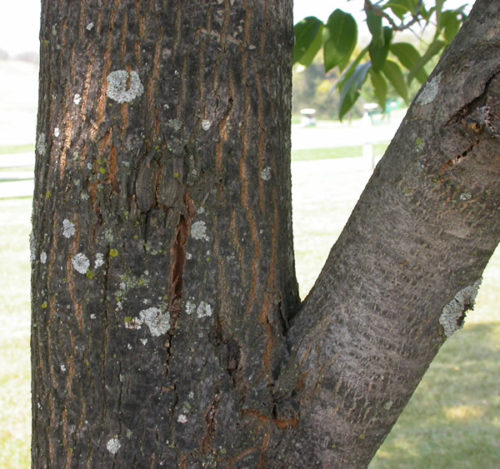 Imidacloprid, the active ingredient works by killing adults when they feed in the summer before they lay eggs. It slowly kills the two youngest stages of grubs that feed beneath the bark. The later and larger two stages are not killed. Material applied in the fall does not start killing beetles until spring. It takes twice the dose in the fall to get the same effect as a spring application. Trees with a trunk diameter of >20 inches at 4.5 ft above the ground can’t be controlled with imidacloprid.
Imidacloprid, the active ingredient works by killing adults when they feed in the summer before they lay eggs. It slowly kills the two youngest stages of grubs that feed beneath the bark. The later and larger two stages are not killed. Material applied in the fall does not start killing beetles until spring. It takes twice the dose in the fall to get the same effect as a spring application. Trees with a trunk diameter of >20 inches at 4.5 ft above the ground can’t be controlled with imidacloprid.
So if your trees are starting to die I would suggest you skip the fall application of imidacloprid and switch to a professional injection of emamectin benzoate. See Management of EAB, Purdue Extension Emerald Ash Borer, for more information.
Resources:
What to do about emerald ash borer, Got Nature?, Purdue Extension-FNR
Emerald Ash Borer, Purdue Extension-Entomology
EAB research: Saving trees early less costly than replacing them, Purdue Agriculture News
Cliff Sadof
Purdue Extension – Entomology
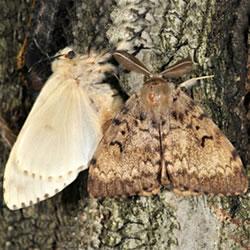
Photo: John Obermeyer
In the late 1860s, French scientist Étienne Trouvelot brought over a seemingly harmless insect from Europe called the gypsy moth to conduct breeding experiments with American moths. When they escaped his backyard and entered into an ecosystem without their native predators, their population exploded. 150 years later, these moths are still a destructive forest pest in Indiana and other states. Every year an effort is made to attempt to curb their population. This year, the Indiana Department of Natural Resources will continue the fight to save our forests from these invasive insects.
Phase one consists of a crop dusting of bacterial chemical spray over the gypsy moth caterpillars’ food sources. This spray is harmless to humans and native wildlife, but is lethal to the caterpillars. Later in the summer, a pheromone will be dispersed over the moths, disrupting the mating process and causing fatal exhaustion.
This huge undertaking isn’t estimated to stop the gypsy moth – in fact, state entomologists don’t see an end in sight. We can only continue to manage this forest pest and aim for reducing populations to a level where local predators can manage them on their own. Indiana citizens can help combat this pest by understanding the gypsy moth problem and learning about its management.
For more information and when the aerial treatments will be conducted in your county visit the Indiana Department of Natural Resources, 2017 Indiana Gypsy Moth Treatment Program. For Tippecanoe view Purdue News.
Resources:
Gypsy Moth (Spongy Moth) website, Purdue Extension-Entomology
Gypsy Moth – Indiana Department of Natural Resources
The Gypsy Moth in Indiana – The Education Store, Purdue Extension resource center
Indiana Department of Natural Resources
This comprehensive written abstract titled Tools for Staging and Managing Emerald Ash Borer in the Urban Forest shares research gathered in an eight-year period with a variety of management strategies.
Advances in control can help municipal foresters save ash trees from emerald ash borer (EAB) [Agrilus planipennis (Fairmaire)]
in urban forests. Although ash trees of any size can be protected from this pest, cities often do not implement programs because they fail to recognize and act o incipient populations of EAB. In this study, researchers develop a model for predicting ash mortality over an eight-year period, and validated with data from the removal of >14,000 ash trees killed by EAB in Fort Wayne, Indiana, U.S. researchers then developed a sampling scheme to help foresters map their ash trees along the expected progression of ash decline. This model was then used to modify a web-based EAB cost calculator that compares discounted annual and cumulative costs of implementing a variety of management strategies. It was determined that strategies that most heavily relied on saving ash trees were less expensive and produced a larger forest than those strategies that mostly removed and replaced ash trees. Ratios of total discounted costs to discounted cumulative benefits of strategies that saved most ash trees were over two-thirds lower than strategies of proactive tree removal and replacement. Delaying implementation of an ash management program until damage would be visible and more obvious to the community (Year 5 of the model) decreased the cost–benefit ratio by <5%. Thus, delays that rely on the abundance of locally damaged trees to bolster community support do not necessarily diminish the utility of implementing a control strategy.
For full article: Tools for Staging and Managing Emerald Ash Borer
Resources:
Tree Doctor App, The Education Store
Invasive Species – Indiana Department of Natural Resources (IDNR)
Ask an Expert – Purdue Extension-Forestry and Natural Resources
Indiana Invasive Species Council – Includes: IDNR, Purdue Department of Entomology and Professional Partners
Great Lakes Early Detection Network App (GLEDN) – The Center for Invasive Species & Ecosystem Health
National Invasive Species Awareness Week: February 27-March 3, 2017
Invasive Species Week a reminder to watch for destructive pests, Purdue entomologist says – Purdue Agriculture News
Cliff Sadof, Professor
Purdue University Department of Entomology
Matt Ginzel, Associate Professor
Purdue University Department of Forestry and Natural Resources & Department of Entomology
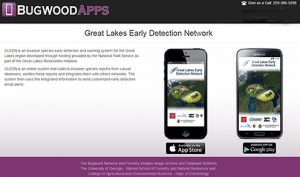 The Forest Pest Outreach and Survey Project at Purdue reminds us that early detection is the best way to slow the spread of invasive species. You can report invasive species by calling the Invasive Species hotline at 1-866-NO-EXOTIC (1-866-663-9684) or using the free Great Lakes Early Detection Network smartphone app, which can be downloaded on iTunes or GooglePlay. View video to see how easy it is to use the app, Great Lakes Early Detection Network App (GLEDN).
The Forest Pest Outreach and Survey Project at Purdue reminds us that early detection is the best way to slow the spread of invasive species. You can report invasive species by calling the Invasive Species hotline at 1-866-NO-EXOTIC (1-866-663-9684) or using the free Great Lakes Early Detection Network smartphone app, which can be downloaded on iTunes or GooglePlay. View video to see how easy it is to use the app, Great Lakes Early Detection Network App (GLEDN).
If you’re interested in learning more about invasive pests and how to report them, sign up for one of our free Early Detector Training workshops!
To register for workshops and to view full article see Forest Pest Outreach and Survey Project.
National Invasive Species Awareness Week: February 27-March 3, 2017.
Resources:
Invasive Species – Indiana Department of Natural Resources (IDNR)
Ask an Expert – Purdue Extension-Forestry and Natural Resources
Indiana Invasive Species Council – Includes: IDNR, Purdue Department of Entomology and Professional Partners
Invasive Species Week a reminder to watch for destructive pests, Purdue entomologist says – Purdue Agriculture News
Sara Stack, MS student
Purdue Department of Entomology
Issue:
Woodlands provide a multitude of environmental (e.g., carbon sequestration, enhance water quality, wildlife habitat), economic (e.g., timber, wood products manufacturing, tourism), and social (e.g., recreation, aesthetics) benefits to Indiana residents. The sustainability of these benefits is strongly tied to stability of the resource. In Indiana, 75 percent of the 4.65 million acres of forestland is owned by families. Actions they take on their property can impact the benefits woodlands provide all Indiana residents. However, many do not understand available options or sources of assistance.
What Has Been Done:
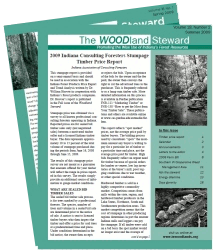 The Department of Forestry and Natural Resources, in partnership with many other organizations, helps produce and mail over 31,000 copies of the Indiana Woodland Steward to woodland owners three times each year. This 16-page, two-color publication includes in-depth articles on forest stewardship and health, invasive species and pests, wildlife habitat management, economics, and more.
The Department of Forestry and Natural Resources, in partnership with many other organizations, helps produce and mail over 31,000 copies of the Indiana Woodland Steward to woodland owners three times each year. This 16-page, two-color publication includes in-depth articles on forest stewardship and health, invasive species and pests, wildlife habitat management, economics, and more.
Results:
Subscribers owned more woods (71.6 ac) for a longer tenure (33 years) than the average woodland owner in Indiana based on data from the National Woodland Owner Survey. As a group, they were also more active managers based on the proportion enrolled in assistance programs and who had a written stewardship plan. Fifty-four percent regularly utilized information from the Woodland Steward. In addition, 51 percent of respondents have implemented at least one practice they read about from The Woodland Steward, potentially impacting an estimated 1.2 million acres of forestland. His use of print media to communicate with woodland owners could be considered expensive, but clearly a large number of woodland owners regularly read and utilize the information making the average investment per landowner much lower.
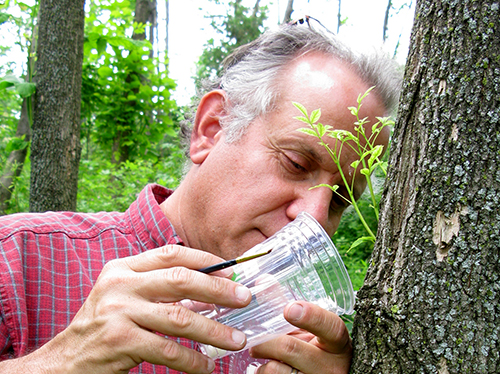 Cities and towns with “urban forests” such as parks and streets lined with trees could spend less money by taking steps to save emerald ash borer-infested trees early rather than wait until they can only replace them, Purdue University researchers concluded in a study.
Cities and towns with “urban forests” such as parks and streets lined with trees could spend less money by taking steps to save emerald ash borer-infested trees early rather than wait until they can only replace them, Purdue University researchers concluded in a study.
Cliff Sadof, professor of Entomology and Matt Ginzel, associate professor in the Department of Entomology and Department of Forestry and Natural Resources, developed a model to help foresters predict the progression of ash decline over time. This model helps them use early reports of damaged trees to alert the community to the imminent threat posed by EAB. The percentage of damaged ash trees in a city typically doubles every year.
Owners of ash trees in Indiana, as well as all around the country, are encouraged to check out the full article provided by Purdue Agriculture News EAB research: Saving trees early less costly than replacing them. You will find several resources on what we can do to aid the ash trees.
Resources:
EAB research: Saving trees early less costly than replacing them – Purdue Agriculture News
Purdue Tree Doctor – Purdue Botany and Plant Pathology
Emerald Ash Borer in Indiana – Purdue Extension
Emerald Ash Borer Cost Calculator – Purdue Extension Entomology
Emerald Ash Borer – Purdue Extension Entomology
Cliff Sadof, Professor of Ornamental and Pest Management
Purdue University Department of Entomology
Matt Ginzel, Associate Professor
Department of Entomology and Department of Forestry & Natural Resources
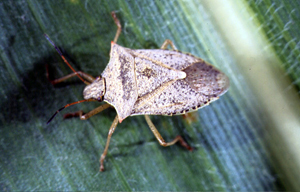
Photo credit: B. Christine
Every fall, a little pest called the brown marmorated stink bug returns to annoy and destroy. This invasive species from the far east has no local predators to control its numbers and does a great deal of damage to fruits, vegetables, and other plants. As the weather cools down, they also like to sneak into homes to stay warm, and will remain there throughout the winter unless dealt with. As the name suggests, these bugs’ defense mechanism is the release of a foul-smelling chemical, and dealing with them can be unpleasant.
Purdue Extension Entomologist Rick Foster answers several questions about stink bugs and what to do about them in a Q&A article for The Star Press. Check out “Stink bug Q&A with Purdue expert” and learn some more about these pesky invaders.
Resources:
Brown Marmorated Stink Bug In Homes – Purdue Extension Entomology
Stink bug Q&A with Purdue expert – The Star Press
Brown Stink Bug – Purdue University Field Crops IPM
Brown marmorated stink bug reported in Indiana for first time – Purdue University News Service
Brown Marmorated Stink Bug – Indiana Cooperative Agricultural Pest Survey (CAPS) Program
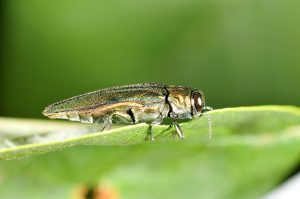
An adult emerald ash borer feeds off a leaf. (Purdue University Department of Entomology photo/John Obermeyer)
Article by Pat Munsey, taken from KokomoPerspective.com:
The ash borer beetle is a scourge that has spread across the Midwest for more than a decade, laying waste to trees as it burrows and feeds. Now it is in Howard County.
Ash trees in several areas of the community are showing signs of the inevitable death that comes with infestation, but citizens can stop the pest in its tracks.
According to the Indiana Department of Natural Resources (DNR), the beetles were first discovered in Indiana on April 21, 2004. Since that time, it has steadily spread across the state with heavy concentrations in the northeast. Evidence of the insects’ arrival locally began appearing two years ago, and according to Kristy McNeil, an associate at Salsbery Garden Center, it is vital that people take action now to prevent further damage.
Resources
The Ash Borers are Here, Kokomo Perspective
Emerald Ash Borer, Indiana Department of Natural Resources (IDNR)
Emerald Ash Borer in Indiana, Purdue Extension
 The emerald ash borer is one of the most destructive insects in the Midwest, killing tens of millions of ash trees. After first being spotted in Indiana in 2004, it has already spread to 95 percent of the state. It is possible to fight off these insects with ash tree pesticides; however, in many cases, it can be too late. Trees missing over half of their canopy are unlikely to be able to carry the pesticide through their trunk to kill the borers. In order for the pesticide to be effective, landowners need to be able to identify signs of an emerald ash borer invasion.
The emerald ash borer is one of the most destructive insects in the Midwest, killing tens of millions of ash trees. After first being spotted in Indiana in 2004, it has already spread to 95 percent of the state. It is possible to fight off these insects with ash tree pesticides; however, in many cases, it can be too late. Trees missing over half of their canopy are unlikely to be able to carry the pesticide through their trunk to kill the borers. In order for the pesticide to be effective, landowners need to be able to identify signs of an emerald ash borer invasion.
In an effort to arm the community with knowledge and effectively deal with these pests, Purdue entomology professor Cliff Sadof and his colleagues have developed the Purdue Tree Doctor App. This $2 application for iPhones and Android phones can save landowners from losing their livelihood to the emerald ash borers by helping them identify and diagnose early signs of infestation and guide them to treatment solutions before it is too late.
To supplement this app, Sadof has also created a web-based emerald ash borer cost calculator to help communities make educated decisions on tree removal, replacement and treatment by projecting costs over 25 years. With the Purdue Tree Doctor app and the EAB cost calculator, the community can more effectively take action and save their ash trees before it’s too late.
Purdue Tree Doctor App
iTunes / Google Play Store
Resources
Emerald Ash Borer Cost Calculator 2.1, Purdue Extension
Emerald Ash Borer in Indiana, Purdue Extension
Insecticide Options for Protecting Ash Trees from Emerald Ash Borer, Purdue Extension
Arrest That Pest! – Emerald Ash Borer in Indiana, Got Nature?
Emerald Ash Borer, Indiana Department of Natural Resources
Invasive Insects, Got Nature?
Cliff Sadof, Professor
Department of Entomology, Purdue University
The sound of cicadas is one of the more distinguishable nature sounds of the Midwestern summer. Whether you love it or hate it, the call of the cicadas will be returning this summer in a different and likely louder way than in the past couple years in Indiana.
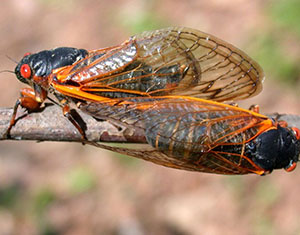
Photo credit: John Obermeyer
Cicadas are interesting insects, living the vast majority of their lives underground as larvae for several years before emerging to the surface to shed their shells and become adults for around a month and reproduce before dying. In general, there are two types of cicadas: annual and periodical.
Annual cicadas are about two inches long and are greenish in color. They are found in vast numbers in the late summer and early autumn. Unlike their name suggests, they live as larvae for two to three years before emerging, but due to overlapping generations, they can be heard every year. They produce their loud, buzzing and ticking calls from their abdomen to attract mates.
In contrast, the periodical cicadas emerge much less frequently. There are two groups of periodical cicadas, one that emerges from its larval state after 13 years and another that emerges after 17. There are 23 observed broods of these that have been well documented by entomologists for decades. These insects are different visually and audibly from their annual relatives. The periodical cicadas have red eyes and orange and black bodies, as opposed to the annual cicada’s green appearance. As well as a buzzing sound, they can also produce a unique, high-pitched tone sounding like “weeee-ooh” or “pharoah.”
Brood XXIII of the 13-year periodic cicadas will emerge this June, and it is expected to be a big one. While loud, these insects are fairly harmless. They don’t pose a risk to humans as they don’t bite or sting. However, the egg laying process can be harmful to young trees with branches less than 3/4 of an inch thick. These trees can be covered with screens to allow sunlight to still reach the trees while keeping the cicadas out. Pesticides are typically avoided since the adult cicadas do not feed on the trees and will not ingest the chemicals.
If you see the periodical cicada emerge in your area, you can email LCaplan@purdue.edu or call 812-435-5287 to help continue to monitor and document these insects.
Resources
Periodical Cicada Reports From Southern Indiana, Purdue Extension
Periodical Cicada In Indiana, Indiana Department of Natural Resources
Periodical Cicada In Indiana, The Education Store
Larry Caplan, Horticulture Educator
Purdue Extension
Recent Posts
- Report Spotted Lanternfly – Purdue Landscape Report
Posted: April 10, 2024 in Alert, Forestry, Invasive Insects, Plants, Wildlife, Woodlands - State of Indiana Proclamation-Invasive Species Week 2024
Posted: February 19, 2024 in Alert, Forestry, Forests and Street Trees, Invasive Animal Species, Invasive Insects, Invasive Plant Species, Urban Forestry, Wildlife, Woodlands - New Invasive Predator of Honeybees-Purdue Landscape Report
Posted: August 27, 2023 in Alert, How To, Invasive Insects, Wildlife - Should Ash Trees Still be Protected From Emerald Ash Borer?
Posted: May 12, 2023 in Forests and Street Trees, Invasive Insects, Urban Forestry - Report if You See a Spotted Lanterfly – MyDNR
Posted: May 10, 2023 in Alert, Forestry, Forests and Street Trees, Invasive Insects, Urban Forestry, Wildlife - Asian jumping worms: Where to get started – Landscape Report
Posted: April 27, 2023 in Invasive Insects, Nature of Teaching, Wildlife, Woodlands - Gardeners Asked to be Vigilant This Spring for Invasive Jumping Worm
Posted: March 17, 2023 in Forestry, How To, Invasive Insects, Plants, Wildlife - ID That Tree: Invasive Tree of Heaven
Posted: February 23, 2023 in Forestry, Forests and Street Trees, Invasive Insects, Invasive Plant Species, Plants, Urban Forestry, Woodlands - Why are the Japanese beetles running late this year?
Posted: July 20, 2022 in Forests and Street Trees, Gardening, How To, Invasive Insects, Urban Forestry, Wildlife - Spotted Lanternfly Feeds on Over 70 Plus Plant Species
Posted: June 2, 2022 in Alert, Forestry, Forests and Street Trees, Gardening, Invasive Insects, Urban Forestry, Wildlife, Woodland Management Moment
Archives
Categories
- Alert
- Aquaculture/Fish
- Aquatic/Aquaculture Resources
- Ask the Expert
- Christmas Trees
- Community Development
- Disease
- Drought
- Forestry
- Forests and Street Trees
- Gardening
- Got Nature for Kids
- Great Lakes
- How To
- Invasive Animal Species
- Invasive Insects
- Invasive Plant Species
- Land Use
- Natural Resource Planning
- Nature of Teaching
- Plants
- Podcasts
- Ponds
- Publication
- Safety
- Timber Marketing
- Uncategorized
- Urban Forestry
- Webinar
- Wildlife
- Wood Products/Manufacturing
- Woodland Management Moment
- Woodlands
